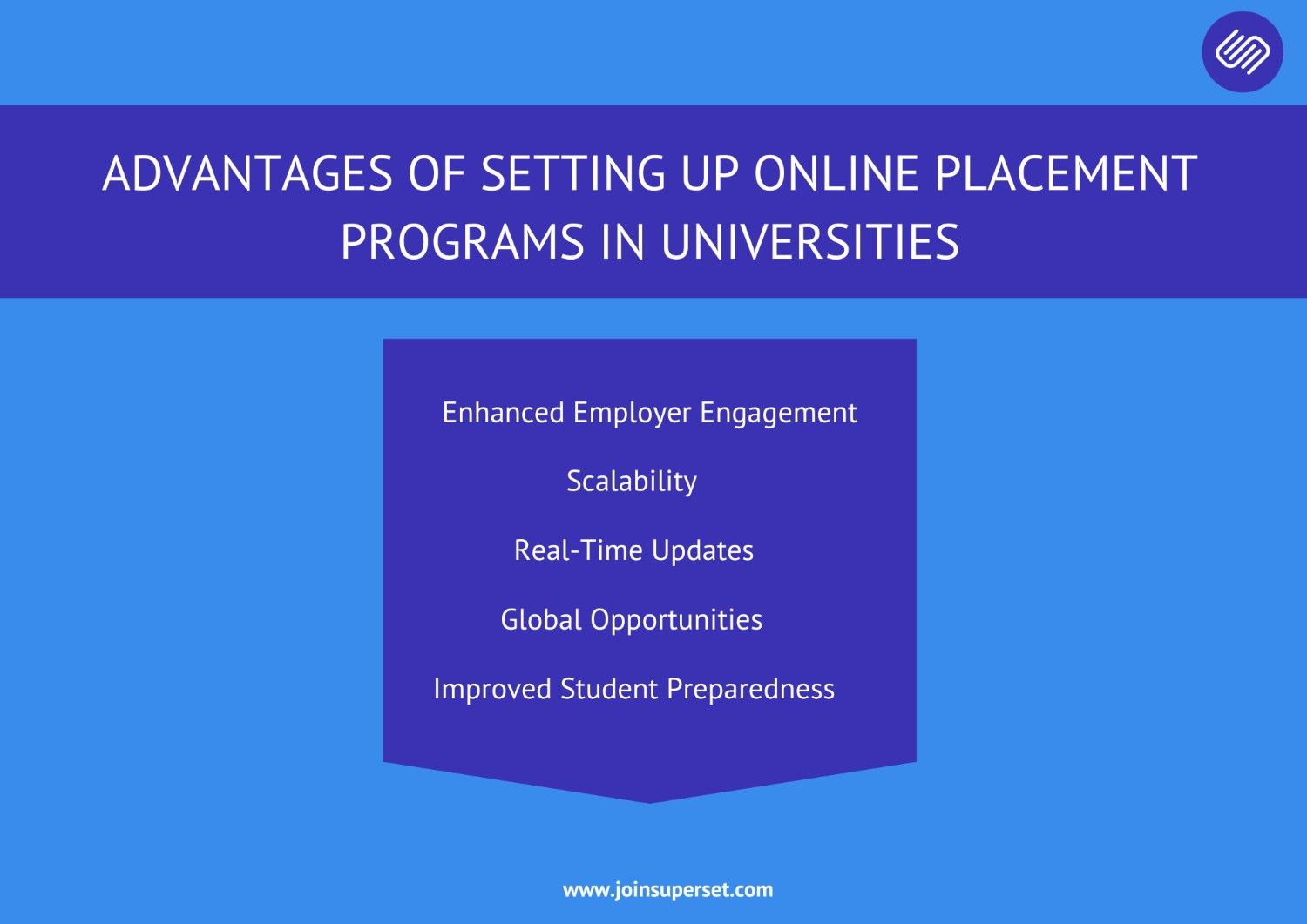In today’s digital age, universities need to adapt to new ways of connecting students with employers. Online placement programs are becoming essential for helping students transition from academia to the workforce. This guide will provide you with straightforward steps and practical advice to set up a successful online placement program at your university. From choosing the right tools to implementing best practices, we’ll cover everything you need to know to ensure your students are ready to embark on their professional journeys with ease and confidence. Whether you’re starting from scratch or improving an existing program, this guide is designed to help you every step of the way.
Why Should Universities Consider Online Placement Programs?
The pandemic has forced many organizations to shift their operations online, and this includes the hiring process. As a result, the demand for online campus drives has increased significantly. By setting up online placement programs, universities can adapt to this changing landscape and provide their students with better opportunities to connect with employers. Online placement programs facilitate a seamless transition from in-person to virtual recruitment, allowing universities to stay current with industry trends. These programs can also help to bridge the gap between academia and the corporate world, ensuring that students are exposed to a more diverse array of career paths and opportunities that may not have been accessible through traditional campus placements.
Increased Reach and Accessibility
One of the main advantages of online placement programs is the increased reach and accessibility. Through these programs, universities can connect their students with employers from all over the country, and even internationally. This allows students to explore a wider range of job opportunities and find the best fit for their skills and interests. Moreover, online placement drives also make it easier for students with disabilities or those who live in remote areas to participate in the hiring process. This promotes inclusivity and ensures that all students have equal access to employment opportunities. In addition to the inclusivity benefits, online placement programs can also help universities establish partnerships with a greater variety of companies, including startups and multinational corporations. This diversification can lead to more robust career support for students and can enhance the institution’s reputation among potential employers.
Efficient and Cost-Effective
Online placement programs offer a more efficient and cost-effective way of conducting campus placements. By eliminating the need for physical infrastructure and logistics, universities can save time and money. Additionally, online drives allow for multiple rounds of interviews to be conducted in a single day, reducing the overall duration of the placement process. Furthermore, online placement drives also eliminate the need for students to travel to different locations for interviews. This not only saves them time and money but also reduces their carbon footprint. By streamlining the recruitment process, universities can also reallocate resources typically used for on-site placement events towards enhancing student training and development programs. This could lead to better-prepared students and potentially higher placement rates.
Data-Driven Decision Making
Online placement programs also offer universities the opportunity to collect and analyze data. With the help of campus placement automation software, universities can track and measure the success of their placement programs. This data can be used to identify areas for improvement and make data-driven decisions to enhance the placement process. The ability to gather and leverage data from online placements can also provide valuable insights into employment trends, student preferences, and employer satisfaction. These insights can help universities tailor their academic programs to better align with industry needs, thereby improving student employability post-graduation.
Steps to Set Up Online Placement Programs
Now that we’ve discussed the benefits of online placement programs, let’s take a look at the steps universities can take to set them up.
Step 1: Identify Your Goals
Before setting up an online placement program, it’s essential to identify your goals. What do you hope to achieve by digitizing your campus placement process? Do you want to increase the number of job opportunities for your students? Do you want to improve the efficiency of the placement process? Clearly defining your objectives will help you create a more effective program. This initial phase is also the time to engage stakeholders, such as faculty, career services staff, and students, to understand their needs and expectations. Their input can be invaluable in shaping the goals and design of your online placement program.
Step 2: Choose the Right Campus Placement Automation Software
The next step is to select the right campus placement automation software. This software will serve as the backbone of your online placement program, so it’s crucial to choose a reliable and user-friendly solution. Look for software that offers features like resume parsing, scheduling interviews, and tracking student data. Additionally, it’s important to ensure the software provides a good user experience for both students and employers. Features like mobile compatibility, easy navigation, and robust support services can go a long way in making the placement process smooth and enjoyable for all participants. These all can done in software like Superset. Superset helps fresh graduates get their first jobs, enables employers to recruit faster, and helps colleges streamline campus placements
Step 3: Create a Student Database
To conduct online placements, you’ll need to create a database of all your students. This database should contain information such as their names, contact details, skills, and academic qualifications. This will allow you to filter and shortlist students for different job opportunities based on their qualifications and interests. Creating a comprehensive student database also lays the groundwork for more personalized career support. By understanding each student’s unique profile, career advisors can provide targeted guidance and help students to better position themselves for the types of roles they are interested in.
Step 4: Invite Employers to Register
After creating a student database, the next step is to invite employers to register for your online placement program. This can be done through various channels, such as social media, email, or word of mouth. Provide employers with all the necessary information about the program, including the date and time of the placement drive, the roles they can offer, and the qualifications they’re looking for. When engaging with employers, it’s also beneficial to highlight the advantages of the online placement program, such as its reach, efficiency, and the quality of candidates they can expect. Building strong relationships with employers can lead to more opportunities for students and potentially long-term partnerships.
Step 5: Conduct Mock Interviews
To help students prepare for online placement drives, universities can conduct mock interviews. This will help students become familiar with the process and gain confidence in their interview skills. Additionally, mock interviews also provide an opportunity for students to receive feedback and improve their performance. Mock interviews can be conducted by faculty members, career advisors, or even industry professionals. This exercise not only prepares students for the actual placement drive but can also be a learning experience that contributes to their professional development.
Step 6: Host the Placement Drive
The final step is to host the online placement drive. This is where the campus placement automation software comes into play. Using the software, employers can schedule interviews with shortlisted candidates, and students can attend the interviews from the comfort of their homes. The software also allows for multiple rounds of interviews to be conducted in a single day, making the process more efficient. After the online placement drive, it’s essential to collect feedback from both students and employers. This feedback can help identify what worked well and what could be improved for future drives. It’s also an opportunity to celebrate successes and share outcomes with the university community.
Continuous Improvement and Follow-Up
Post-placement feedback and data analysis are crucial for continuous improvement. Universities should regularly review the outcomes of their online placement programs, using data from campus placement digitisation to refine their approach. This could involve updating the campus placement automation software, incorporating new training modules based on employer feedback, or adjusting the timeline of the placement process. Continuous improvement ensures that the online placement program remains effective and aligned with industry standards and student needs.
Promoting Student Engagement and Preparedness
Effective online placement programs go beyond simply setting up the technical infrastructure; they also focus on student engagement and preparedness. Universities should implement regular workshops, webinars, and training sessions to equip students with the necessary skills for virtual interviews and remote work environments. Topics can include resume building, interview techniques, digital communication skills, and professional etiquette. Encouraging students to participate in these activities not only boosts their confidence but also increases their chances of success during the placement process.
The Role of Alumni in Online Placements
Alumni can play a significant role in enhancing the success of online placement programs. Universities can leverage their alumni network to provide mentorship, conduct mock interviews, and share insights about industry trends and expectations. Alumni can also help in expanding the university’s network of potential employers by referring companies looking to hire fresh talent. Involving alumni in the placement process not only benefits current students but also strengthens the relationship between alumni and the university. This can lead to long-term collaborations and support for the university’s placement initiatives
Advantages of Setting Up Online Placement Programs in Universities
Setting up online placement programs offers numerous advantages for universities. Here are some key benefits:

- Enhanced Employer Engagement: Online placement programs allow universities to engage with a broader range of employers. This increased engagement can lead to more job opportunities for students and stronger partnerships with industry leaders.
- Scalability: Online placement programs are highly scalable. Universities can easily accommodate a larger number of students and employers without the limitations of physical space and resources. This scalability ensures that more students can participate in placement drives, increasing their chances of securing employment.
- Real-Time Updates: With campus placement automation software, universities can provide real-time updates to students and employers. This instant communication streamlines the process, ensuring that everyone is informed about changes, schedules, and updates promptly.
- Global Opportunities: Online placement programs open up global job opportunities for students. By connecting with international employers, universities can provide students with access to diverse career paths and the chance to work in different parts of the world.
- Improved Student Preparedness: The structured approach of online placement programs, including mock interviews and data-driven insights, helps improve student preparedness. This leads to better performance during actual interviews and higher placement success rates.
Conclusion
The demand for online campus drives is on the rise, and universities must adapt to this new trend. By setting up online placement programs, universities can increase their reach, improve the efficiency of the placement process, and make data-driven decisions to enhance their programs. With the right campus placement automation software and the steps outlined in this article, universities can successfully set up online placement programs and provide their students with better employment opportunities. Embracing the shift towards online placement programs is not just about keeping up with technological advancements; it’s about providing students with the tools and opportunities they need to succeed in an increasingly competitive job market. As more universities recognize the benefits of these programs, online campus digitisation will likely become the new standard in the years to come.








